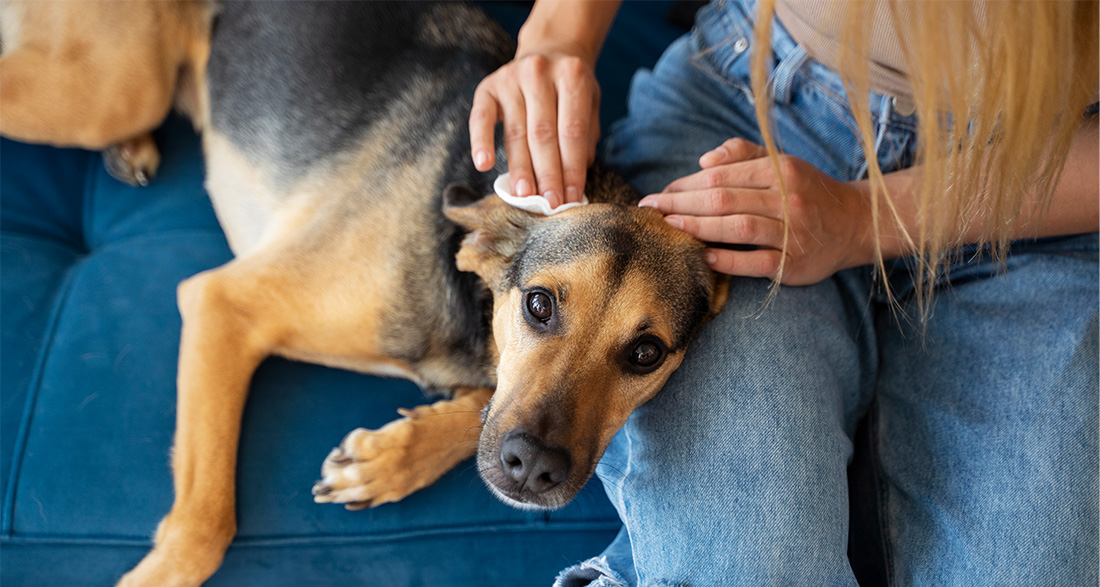Beautiful weather and pleasant temperatures are ideal for being outdoors with dogs. However, this is not entirely without risk, as summer is also insect season. If you’re not careful, a sting from a bee, wasp, hornet, mosquito, or other insects can quickly become dangerous for your dog.
- Are insect bites dangerous for dogs?
- Recognizing insect bites in dogs
- Symptoms in dogs after an insect bite
- Recognizing dangerous insect bites in dogs
- Recognizing allergic reactions to insect bites in dogs
- What to do if the dog is stung by an insect?
- These home remedies help against an insect bite in dogs
- Preventing insect bites in dogs
Are insect bites dangerous for dogs?
An insect bite is not only painful and accompanied by unpleasant itching for dogs, but a bee sting or similar can also become life-threatening.
What makes insect bites particularly dangerous for dogs is when the animals are stung by insects in the respiratory tract or if they have an allergic reaction to the sting. Swelling and other symptoms in dogs can lead to difficulty breathing, unconsciousness, and ultimately the death of the animal.
Some insects also transmit diseases and parasites; for example, the increasingly prevalent Asian tiger mosquito transmits heartworm larvae.
What you can do to help your dog after an insect bite is explained in this dog guide.
Recognizing insect bites in dogs
When your four-legged friend happily frolics across the meadow or plays in the backyard, owners may not always have their dogs completely in view. Playful or curious dogs may start chasing wasps, bees, and other insects. If the insects feel threatened, they sting, which can be very painful and equally dangerous for the dog.
Dog owners should be able to quickly recognize insect bites to alleviate their dog’s suffering and prevent serious consequences.
Symptoms in dogs after an insect bite
It is usually easy to recognize whether the dog has been stung by a wasp, bee, or another insect.
The following indications suggest an insect bite in dogs:
- Loud yelping or whining
- Sudden fleeing
- Intense licking, scratching, or biting of a body part (itching)
- Compulsive rubbing on the ground, trees, or other surfaces
- Restlessness
- Redness of the skin
- Swelling or lump on the dog’s body
- Limping or other protective postures
Itching and swelling can last for several hours to one or two days in dogs. In case of doubt, it is advisable to have the dog examined by a veterinarian.

Recognizing dangerous insect bites in dogs
It is particularly dangerous if the dog is stung in the oral cavity and in the respiratory tract. This often happens when dogs swallow a wasp, bee, or something similar.
Early signs of dangerous insect bites in dogs include:
- Swelling in the face, snout, or throat
- Difficulty or shortness of breath
- Coughing
- Gagging and vomiting
- Excessive drooling
Small dogs tolerate less insect venom compared to larger ones. If a dog is stung multiple times, it can quickly become a health hazard. If a change in breathing is observed, the dog should be taken to a veterinary practice immediately. A visit to the vet after an insect bite is generally recommended for short-nosed dog breeds.
Recognizing allergic reactions to insect bites in dogs
An insect bite can be life-threatening if the dog reacts allergically. Those who want to know if the dog is allergic can have appropriate tests done at the veterinary practice. Dogs with an allergy show severe symptoms after an insect bite.
Signs of an allergic reaction in dogs:
- Trembling
- Staggering
- Lethargy
- Weakness or unconsciousness
- Rapid, shallow breathing
- Difficulty breathing
- Pale or whitish mucous membranes in the dog’s mouth
- Increased salivation
- Gagging and vomiting
- Diarrhea
- Fever
- Dry cough
- Seizure
- Rash (hives)
Such an anaphylactic shock in dogs is always an emergency that requires veterinary treatment.

What to do if the dog is stung by an insect?
If the symptoms are mild and there is slight swelling that does not endanger the dog’s health, the insect bite can be treated at home. Anything beyond that requires veterinary care.
First aid for the dog after an insect bite:
- Step 1: Stay calm and, if necessary, calm the dog.
- Step 2: Locate the puncture site on the dog and carefully remove any remaining stinger if present. It is important not to crush the venom gland at the end of the stinger, as this could introduce more venom into the dog’s body.
- Step 3: Cool the affected area. Wrap an ice pack or something from the freezer in a cloth and gently press it onto the site. If the sting is in the mouth or throat, you can offer the dog lactose-free and cold yogurt, quark, or dog ice cream.
After a sting, the dog should be observed for at least two hours. If worrying symptoms occur, the animal should be medically examined.
These home remedies help against an insect bite in dogs
The most helpful thing for the dog is to cool the insect bite. Home remedies can support the healing process for mild stings.
Home remedies for dogs with an insect bite:
- Crush parsley, basil, and marigold and apply the paste to the sting.
- Quark pack (preferably use lactose-free quark).
Caution
Onion, a proven home remedy for mosquito and other insect bites, is not recommended for dogs as onions are toxic to them, and even small amounts can be life-threatening.
Preventing insect bites in dogs
Tips to avoid insect bites in dogs:
- Check the water bowl and dog food for insects.
- Do not leave food open or outside.
- Do not feed the dog outdoors.
- Keep the dog away from beehives and wasp nests.
- Train recall to prevent the dog from hunting insects.
- Regularly collect and dispose of fallen fruit in the garden.
- Choose mowed grass areas instead of flower meadows for the dog to play.
- Use special insect repellents or appropriate collars for dogs.
- Always know where the nearest veterinary practice is located.
If dog sitters and other individuals are with the dog, they should be instructed accordingly in advance.
Conclusion
An insect bite in dogs should never be underestimated and should be avoided as much as possible. As soon as the dog shows serious symptoms, veterinary treatment is necessary.


